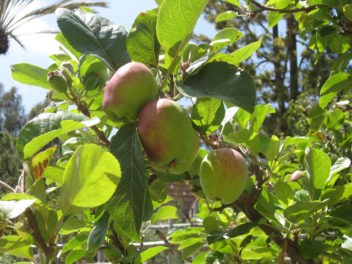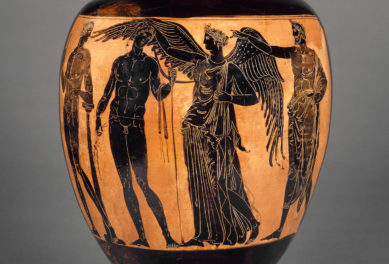
Black-Figure Column Krater (detail), about 520 BC, Painter of Munich 1736. Terracotta, 18 1/2 × 21 1/4 × 18 9/16 in. 75.AE.106. Digital image courtesy of the Getty’s Open Content Program.
Forget Valentine’s Day, Happy Anthesteria!
This ancient Greek holiday that you’ve probably never heard of was a three-day festival in honor of Dionysus, the god of wine. Everyone participated, including women, children, hired servants, and household slaves, and it featured excessive wine-drinking as part of the celebration of two seemingly unrelated things: springtime and death.
The festival also honored the ghosts of the dead, who were believed to walk the streets.
The holiday is either named after or gives its name to the Greek month Anthesterion (late February to early March), but both likely derive from the Greek word for flower, anthos—referring to the first blooms of the grapevine in spring.
Timed to take place on three days leading up to the Anthesterion full moon, the festival fell on different days of the month depending on the year. Adjusting this to modern calendars, it begins about four days before the February full moon. In years when the full moon is very early (in the first few days of the month), the holiday takes place at the end of the month before the early March moon.
Day 1: Pithoigia “Jar-Opening Day”

Cup with a Woman Drinking in a Storeroom; about 470–460 BC, unknown artist. Terracotta 6 × 10 13/16 × 7 1/16 in. 86.AE.265. Digital image courtesy of the Getty’s Open Content Program.
On the first day, large vats (pithoi) containing new wine from the past year were ceremonially opened, wine offerings were poured out to Dionysus, and the wine was tasted. It was a moment to drink to a good harvest and to the end of winter. This was a solemn affair—a mix of superstitious fear towards winter and thanksgiving for the coming spring.
In contrast with the solemnity and restraint of the first day’s drinking, the cup (skyphos) pictured above shows a woman gulping down wine with urgency.
Day 2: Choes “Wine-jug Day”
On the second day, the festival really got going—drinking cups were replaced with wine-jugs (choes), giving the day its name. Celebrants would carry around their own personal wine-jug filled with pre-mixed wine.
A normal chous held about twelve large drinking cups, approximately three quarts, the standard amount of wine for the drinking contests. (Don’t worry, the wine would have been mixed and diluted with water!)
An official public drinking contest was held. The first person to empty his or her chous was crowned the victor and given a full wineskin as a prize.
The state performed its own ceremony in a temple of Dionysos, where the wife of the chief magistrate celebrated a sacred ritual marriage with the god.

Wine Jug with a Drunken Man Singing, about 470 BC, Oionokles Painter. Terracotta, 9 1/16 × 7 5/16 in. 86.AE.237. Digital image courtesy of the Getty’s Open Content Program.
This chous features a singing man—with his head tilted back and his hand thrust out dramatically, he seems to have consumed one too many jugs of wine. Luckily, a servant-boy is there, anticipating his master’s needs, and holds out a vessel for him to relieve himself.
The scene of drunken revelry is an appropriate decoration for a vessel so closely associated with the Anthesteria festival.

Wine Jug with Knucklebone Players, 420 BC, Group of Boston 10.190. Terracotta, 6 13/16 in. 96.AE.28. Digital image courtesy of the Getty’s Open Content Program.
Striking a different tone, this chous is decorated with a scene of three boys playing knucklebones. In fact, representations of children are quite common on Anthesteria wine-jugs since the festival was an important milestone for young boys. During the festival boys as young as three were given their own little wine jugs, and formally accepted into their father’s kinship groups, becoming part of the community.
In the midst of this drinking and merrymaking, the second day of Anthesteria was also when the ghosts of the dead were believed to walk around outside. Dionysus, a contradictory god of wine, rebirth, and transformation, was also associated with death and the hope of a blessed afterlife.
Day 3: Chytroi “Day of Cooking Pots”
After two days of celebrating the coming of Dionysus, day three was devoted to remembering the dead. During Anthesteria, souls of the dead were believed to return from the underworld and walk among the living. People would take precautions against these unlucky spirits by chewing buckthorn, smearing their doorways with pitch, and locking up all the sanctuaries to keep them out (only the temple of Dionysus remained open).
The third day marked a return to normalcy through special rituals. Families would prepare cooked grains in clay pots as offerings to Hermes Psychopompos (Hermes the Conveyor of Souls) and to the souls of the dead—much like the modern All Souls Day or Día de Muertos.

White-ground lekythos with Hermes and Charon, 450-440 BC, attributed to the Thanatos Painter. Terracotta. State Collections of Antiquities and Glyptothek Munich.
This oil jar shows Hermes, wearing his winged cap, guiding a young woman to the underworld. Holding her arm, he leads her towards the ferryman Charon (already in his boat) who will convey her across the River Styx to the House of Hades.
At the end of the day, the spirits were then asked to return to the underworld, families would shout, “Out the door spirits! Anthesteria is over!” thus ending the topsy-turvy festival and restoring the world’s normal order.




Comments on this post are now closed.